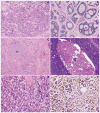Predictors of Outcome in Adenoid Cystic Carcinoma of Salivary Glands: A Clinicopathologic Study With Correlation Between MYB Fusion and Protein Expression
- PMID: 28719465
- PMCID: PMC5597477
- DOI: 10.1097/PAS.0000000000000918
Predictors of Outcome in Adenoid Cystic Carcinoma of Salivary Glands: A Clinicopathologic Study With Correlation Between MYB Fusion and Protein Expression
Abstract
Adenoid cystic carcinoma (ACC) is the second most common salivary gland malignancy and it has a high rate of recurrences and a poor long-term prognosis. Our aim was to assess the prognostic factors in ACC and study MYB-NFIB fusion and MYB protein expression in a large retrospective cohort of 135 patients with a median follow-up of 6.3 years. The 5- and 10-year local recurrence-free survival (RFS) rate of 94% and 78%, 5- and 10-year distant metastasis survival rate of 77% and 58%, and 5- and 10-year RFS of 66% and 44%. The following features were identified as adverse prognostic factors of RFS on univariate analysis: large tumor size, solid growth pattern, increased mitoses, positive margin, American Joint Committee on Cancer clinical staging, high-grade transformation, vascular invasion, nuclear atypia, open chromatin, prominent nucleoli, and tumor necrosis. However, on multivariate analysis, only increased mitoses (≥5/10 high-power fields), any solid growth pattern, and advanced American Joint Committee on Cancer TNM staging were independent adverse predictors for RFS. MYB immunoexpression and MYB-NFIB translocation were common findings in ACC, occurring in 72% and 59% of the tested ACCs, respectively. The sensitivity and specificity of MYB immunohistochemistry in detecting MYB-NFIB fusion was relatively low at 78% sensitivity and 50% specificity. The high prevalence of alterations leading to high expression of the MYB transcription factor family suggests that targeted approaches developed to suppress the expression of these oncogenic transcription factors and/or the transcriptional activity of these proteins would be a rational therapeutic approach to investigate in ACC.
Conflict of interest statement
The authors have disclosed that they have no significant relationships with, or financial interest in any commercial companies pertaining to this article.
Figures



References
-
- Spiro RH, Huvos AG, Strong EW. Adenoid cystic carcinoma of salivary origin. A clinicopathologic study of 242 cases. Am J Surg. 1974;128:512–520. - PubMed
-
- Barnes EL, Eveson JW, Reichart P, et al. World Health Organization Classification of Tumours: pathology and genetics of head and neck tumours. Lyon: International Agency for Research on Cancer (IARC); 2005.
-
- Oplatek A, Ozer E, Agrawal A, et al. Patterns of recurrence and survival of head and neck adenoid cystic carcinoma after definitive resection. Laryngoscope. 2010;120:65–70. - PubMed
-
- Nascimento AG, Amaral AL, Prado LA, et al. Adenoid cystic carcinoma of salivary glands. A study of 61 cases with clinicopathologic correlation. Cancer. 1986;57:312–319. - PubMed
-
- Jones AS, Hamilton JW, Rowley H, et al. Adenoid cystic carcinoma of the head and neck. Clin Otolaryngol Allied Sci. 1997;22:434–443. - PubMed
MeSH terms
Substances
Grants and funding
LinkOut - more resources
Full Text Sources
Other Literature Sources
Medical

